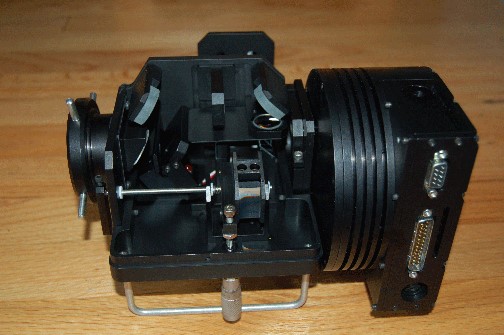SGS (Self-Guiding Spectrograph)

The Self-Guiding Spectrograph is designed to be used with an ST-7E camera. Although it can also be used with an ST-8E, there is no advantage in bandwidth when using the larger format camera. The spectrometer and ST-7/8 are coupled and mounted as a unit onto the telescope (See Figure 1). The system is quite handy for collecting spectra since both the object of interest and the spectrometer entrance slit are simultaneously imaged onto the tracking CCD, allowing the object to be viewed and accurately placed onto the slit. The slit is backlit by an LED during the setup so it clearly shows on the tracking CCD. Once the object is maneuvered onto the slit, self guiding will then hold the object on the slit.
SBIG's Self-Guided Spectrograph Capabilities
- Measure Stellar Spectra:
- Determine spectral class
- Measure radial velocities
- Measure Emission Nebula:
- Determine spectral lines
- Measure relative line strengths
- Measure Galactic Objects:
- Measure radial velocity (red shift) of brighter galaxies
- Distinguish quasars from other objects
General Specifications
The spectrometer is designed to operate with the ST-7/8. The object that is to be analyzed is viewed on the tracking CCD, simultaneously with the slit. The slit is backlit by an LED during setup to render it clearly visible on the tracking CCD. The object is manually maneuvered onto the slit using the telescope controls, and is held there using SELF GUIDING during a long exposure. The spectra is recorded by the imaging CCD, oriented long-ways so the spectra falls across 763 pixels, with a height of about 16 pixels for stellar sources. Two gratings and two slits are available for maximum versatility. The standard grating, 150 rulings per mm, gives a dispersion of 4.3 angstroms per pixel, and allows the user to capture the entire interesting range from the calcium H and K lines to H-Alpha with a single exposure. Depending on the slit size, the resolution will be 10 or 38 angstroms per pixel. An interchangeable high resolution grating can also be used that gives 1.07 angstrom per pixel dispersion, with a resolution of about 2.4 angstroms when used with the narrow slit. The spectral range is smaller, being only about 75 angstroms. This resolution is adequate to detect the Doppler shift due to the earth’s motion around the sun when carefully calibrated, and detect spectroscopic binaries.

